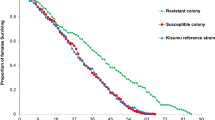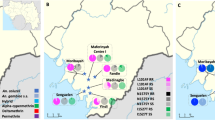Abstract
THE tolerance to insecticides of normal and resistant strains of A. gambiae Giles has been measured by a number of workers1–3, but so far no figures for A. funestus, the second main malaria vector of Africa, seem to have been published. This communication records the results of tests carried out on this species in an area of Sokoto Province, Northern Nigeria, about ten miles west of the sprayed zones of the Western Sokoto Malaria Control Pilot Project. The test for susceptibility described by Busvine4 was applied to wild-caught females in the blood-fed and gravid states. Results are summarized in Table 1.
This is a preview of subscription content, access via your institution
Access options
Subscribe to this journal
Receive 51 print issues and online access
$199.00 per year
only $3.90 per issue
Buy this article
- Purchase on Springer Link
- Instant access to full article PDF
Prices may be subject to local taxes which are calculated during checkout
Similar content being viewed by others
References
Elliott, R., and Ramakrishna, V., Nature, 177, 532 (1956).
Busvine, J. R., Nature, 177, 534 (1956).
Davidson, G., Nature, 178, 705 (1956).
Busvine, J. R., World Health Org., Tech. Series, Report No. 80 (1954).
Litchfield, J. T., and Wilcoxon, F., J. Pharm. and Exp. Ther., 96, 99 (1949).
Author information
Authors and Affiliations
Rights and permissions
About this article
Cite this article
RAMAKRISHNA, V., ELLIOTT, R. Normal Resistance-level of Anopheles funestus Giles to Insecticides. Nature 179, 1140–1141 (1957). https://doi.org/10.1038/1791140b0
Issue Date:
DOI: https://doi.org/10.1038/1791140b0
Comments
By submitting a comment you agree to abide by our Terms and Community Guidelines. If you find something abusive or that does not comply with our terms or guidelines please flag it as inappropriate.



